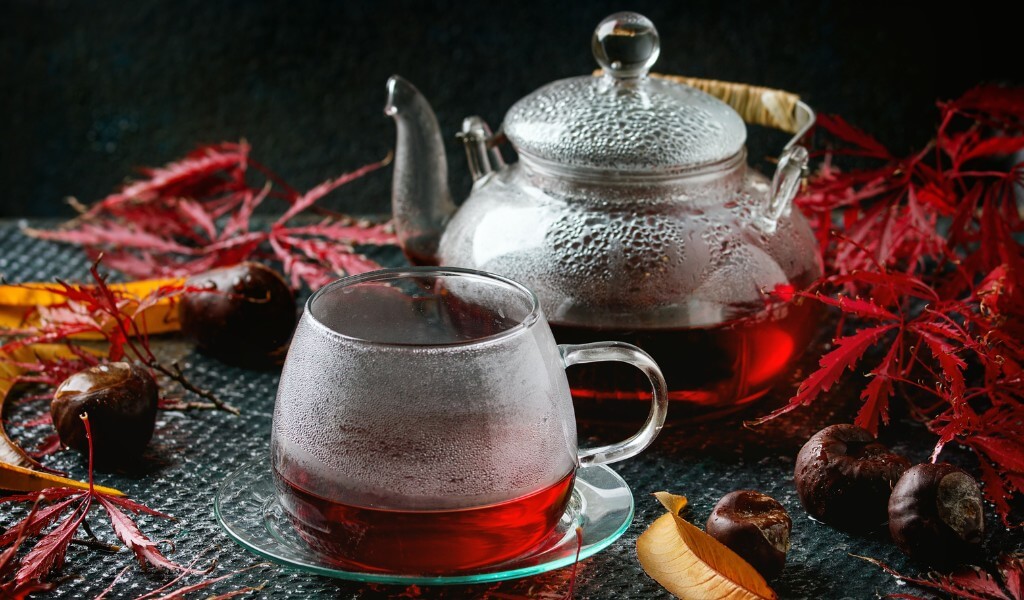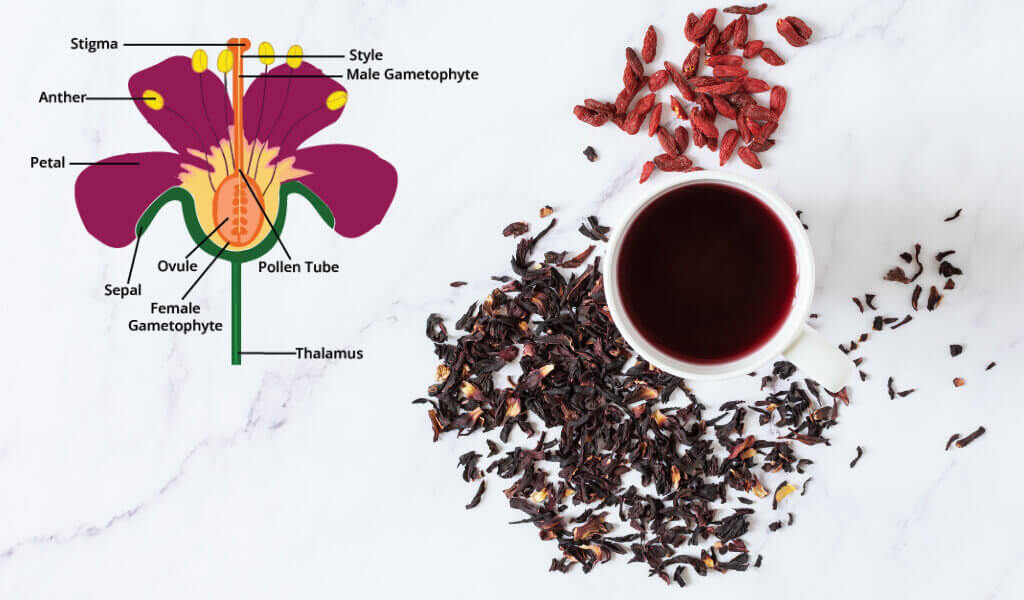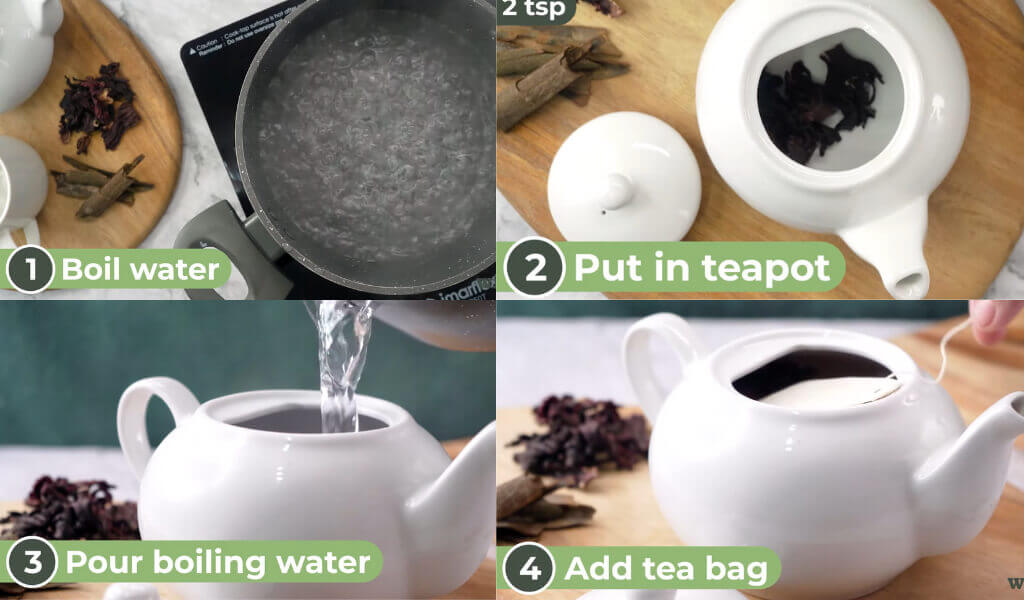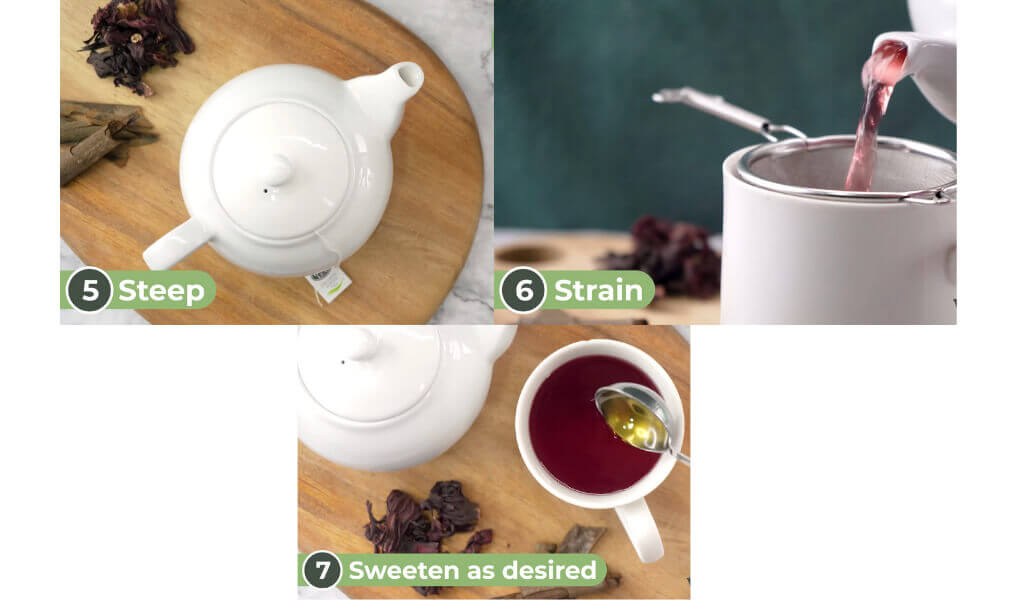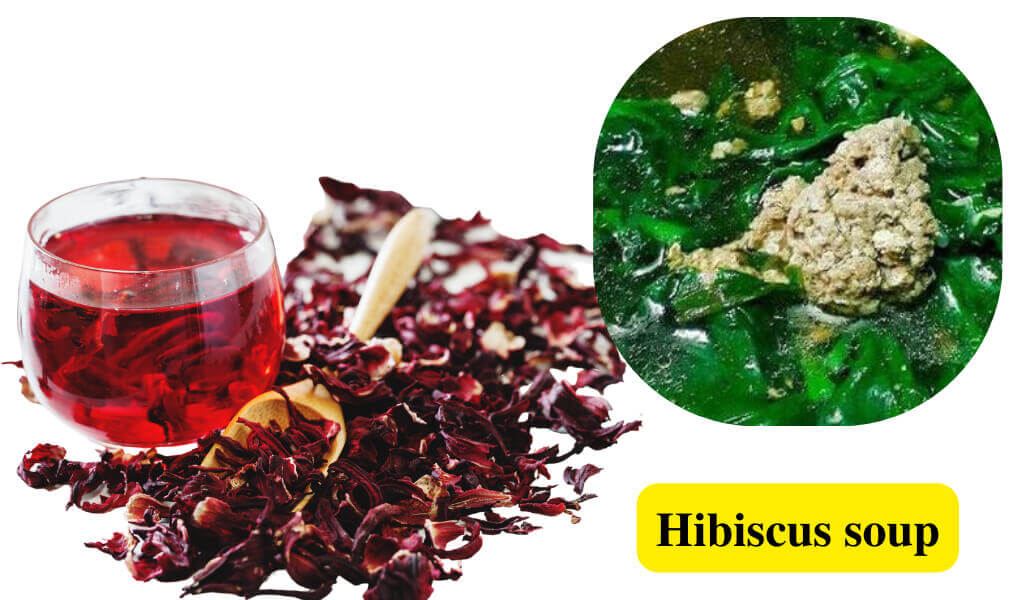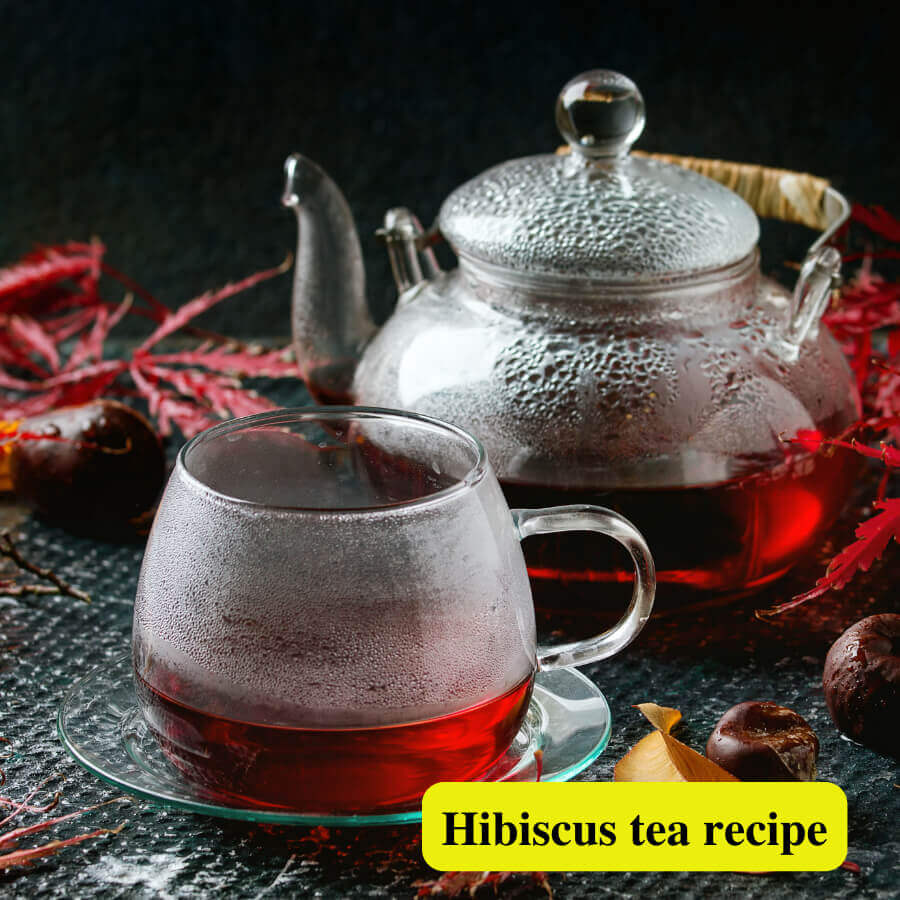Looking for a refreshing way how to make Hibiscus tea to your routine? Look no further than hibiscus tea! If you’re wondering about the detailed guide, you’ve come to the right place.
In this article, we’ll walk you through the steps to create a delicious cup of Hibiscus Tea and provide some insights into its potential health benefits.
But first, tell me: have you ever tried Hibiscus Tea before? What did you think of it? And if you have yet to try it? Let’s explore the world of hibiscus recipes together!
Quotes of tea with You
“Tea, though ridiculed by those who are naturally coarse in their nervous sensibilities will always be the favorite beverage of the intellectual.”
– Thomas de Quincey
What are the edible parts of hibiscus?
It’s best to stick to eating only the petals of the hibiscus flower. Cooking doesn’t require using the stamen, calyx, pistil, or pollen, so they’re thrown away.
So, which Hibiscus is used for tea? That being said, some authors suggest that the pistil can be eaten and is safe for consumption. However, you’re new to cooking with hibiscus. In that case, it’s best to stick to the petals and avoid using other parts of the flower just to be safe.
How to make Hibiscus Tea
I can’t wait to share with you some benefits of Hibiscus Tea. This tea may be made with fresh or dried hibiscus blossoms and is delicious served hot or as a cool iced tea. I assure you that it is a tasty and pleasant option in any case.
So, let’s get started and learn to make tea together!
How to prepare Hibiscus Tea Ingredients
Here are the ingredients you’ll need to make a delicious batch of Hibiscus Tea:
- 2 cups of fresh hibiscus flowers or ½ cup of dried hibiscus flowers
- 8 cups of water
- ¼ cup of honey (add more if you prefer a sweeter taste)
- 3 tablespoons of fresh lime juice
Instructions
- If you’re using fresh hibiscus flowers, remove the green part at the base of the stem (also known as the calyx) to which the stem is attached. You can take out the pistil, the slender tube-like part in the center of the flower that carries pollen. However, this step is not necessary. If you’re working with dried flowers, you can skip this part.
- Bring the hibiscus flowers and water to a boil in a large pot. Once the water has started boiling, turn off the heat and cover the pot. You can add other herbs or add-ins, such as basil, lemongrass, or lemon zest to enhance the flavor. Let the tea steep for 15-20 minutes.
- After steeping, mix the honey and lime juice until thoroughly combined. Then, strain the tea to remove any remaining bits of flower or herbs.
- You can choose to serve the Hibiscus Tea warm or chilled. If you want to enjoy it cold, simply place the tea in the refrigerator for a few hours before serving. Either way, it’s a tasty and refreshing beverage perfect for any day.
Notes
Here are a few tips and tricks to help you customize your Hibiscus Tea to your liking:
- Add-ins: To experiment with different flavors, add some of your favorite herbs or citrus fruits to the tea. Basil, lemongrass, lemon zest, and mint all complement the taste of hibiscus well.
- Sweetness: While we prefer our tea to be moderately sweet, you can adjust the sweetness level to your liking by adding more honey or replacing it with sugar or jaggery.
- Steeping time: Be careful not to steep the petals for too long, as this can make the tea taste bitter. Stick to a steeping time of 15-20 minutes for the best flavor.
- Sweetener substitution: If you don’t have honey on hand, you can substitute it with sugar or jaggery for a similar level of sweetness.
- Serving temperature: While Hibiscus Tea can be enjoyed both hot and cold, it’s best to serve it hot immediately after brewing for the most satisfying experience.
Nutrition
- Calories: 89kcal
- Carbohydrates: 22g
- Protein: 1g
- Fat: 1g
- Saturated Fat: 1g
- Sodium: 23mg
- Potassium: 28mg
- Fiber: 1g
- Sugar: 20g
- Vitamin A: 280IU
- Vitamin C: 20mg
- Calcium: 11mg
- Iron: 8mg
(Nutrition information for our recipes was calculated using an ingredient database and should be considered an estimate; individual results may vary.)
Read More: Let’s find out: Can I drink hibiscus tea in the morning?
Benefits of including hibiscus tea in your diet
So, is hibiscus tea good for you? The hibiscus plant is known to be incredibly beneficial to our health, and incorporating it into our daily routine is a safe and healthy choice. This quick and easy brew packs a powerful punch of herbal goodness. It’s super easy to make and quick too! Plus, not only does it taste great, but it’s also good for your health. So why give it a try and see for yourself?
Here are some of the ways Hibiscus tea can help improve your health:
- Lowers blood pressure: Reducing your risk of heart disease by helping to lower your blood pressure.
- Rich in antioxidants: This provides your body with abundant antioxidants that can protect your cells and prevent damage from free radicals.
- Immunity booster: Stimulates T cells and B cells, helping to give your immune system a boost.
- Lowers cholesterol: Helps reduce fat blood levels, which can lead to lower cholesterol levels in the body.
- Alleviates period pains: May help with menstrual cramps and hormonal imbalances.
- Detoxifies the body: Helps to improve liver function, removing toxins from the body.
So why not add Hibiscus tea to your daily routine and enjoy these incredible health benefits?
Storage Homemade Hibiscus Tea Instructions
Hibiscus tea is simple to keep and drink later, so don’t worry if you have some remaining. Place it in the fridge to keep for up to five days. This makes it an easy drink to prepare ahead of time that is ideal for hectic schedules. When you’re ready to consume it, you can either reheat it if you prefer it hot or drink it cold straight from the refrigerator.
Any remaining tea can be frozen into ice cubes as a fun alternative. These hibiscus tea ice cubes give a delicious taste and are a delightful complement to any beverage. Even better, you could use the remaining tea to make hibiscus popsicles, a refreshing and healthful treat ideal for warm weather.
How to make Hibiscus Tea, either as a warm, soothing herbal tea OR a sweet, tangy, refreshing cold brew or iced tea (aka Agua de Jamaica). Multiple flavor variations are included below!
Whether looking for something warm and soothing on chilly days or chilled and refreshing during the summer, hibiscus tea is a must-try! It’s sweet, tangy (like cranberry juice), beautiful (look at the color!), and packed with health benefits – making it a great alternative to caffeinated drinks or soda.
You can enjoy these Hibiscus Tea recipes year-round, made with either hibiscus flowers straight from your garden or dried flowers. With just 2 base ingredients, there are plenty of ways to add even more flavor to the tea.
Read More: Do you love indulging in tea but are also cautious about caffeine intake? Then, with its vibrant color and tangy flavor, hibiscus tea is caffeine-free. Check out the article: is Hibiscus tea caffeine free?
Hibiscus Tea Recipe Tips And Notes
When it comes to making hibiscus tea, there are a few things to keep in mind to ensure the best results:
Adjust the sweetness: The sweetness level is a matter of personal taste, so feel free to adjust it to your liking. Some people prefer their tea very tart, while others like it on the sweeter side.
Adjust the strength: To find the perfect balance of flavor, you can experiment with the ratio of hibiscus to water and how long you leave the tea steep. Just be careful not to steep the petals too long, as this can make the tea taste bitter. If this happens, try increasing the ratio of flowers instead.
Beware of hibiscus stains: Hibiscus can stain clothing and surfaces. When preparing hibiscus drinks, be mindful of what you wear and your surfaces. If you encounter stains, you can try to remove them through various methods.
With these tips, you can make the perfect cup of hibiscus tea customized to your preferences.
Don’t forget to share Spiritea Drinks post with your loved ones.
FAQs
Is it possible to use the entire hibiscus flower?
Suppose you’re wondering which parts of the hibiscus flower to use for making tea. In that case, it’s pretty simple – only the petals are needed! The stamen, stem, and other parts can be discarded.
I prefer to buy pre-dried hibiscus petals, eliminating the need for filtering. This saves time and makes the process even more convenient. So, stick to just the petals for an easy and hassle-free experience.
Are fresh hibiscus petals usable?
Yes, you can use fresh hibiscus petals to make tea! Remember that you’ll need about four times more fresh petals than dried petals (1 cup instead of ¼ cup). I recommend increasing the steeping time to 15 minutes for the best flavor.
Where can I buy hibiscus flowers?
Now, where buy hibiscus tea and flowers? A few options are available if you’re looking to buy dried hibiscus flowers for making tea. You can easily find packages of dried flowers online or in health food stores.
What is the recommended daily intake of hibiscus tea?
To get the most out of the health benefits that Hibiscus Tea has to offer, I recommend consuming 1-2 cups of this delicious drink per day. This is a safe and effective way to reap the rewards of hibiscus without overdoing it, which can lead to potential side effects. So, enjoy a cup or two of hibiscus tea daily to support your health and well-being!
How can I dry hibiscus flowers at home?
If you have fresh hibiscus flowers and want to dry them for later use, it’s a simple process! Start by removing the stem and stamen from each flower, but keep the calyx intact. Then, place the flowers on a large drying rack covered in muslin and leave them in a well-ventilated area.
I’m Shanna, creator of Spiritea Drinks. I’m all about teaching people to grow their own food, tea, cook what they harvest, and eat with the seasons.

